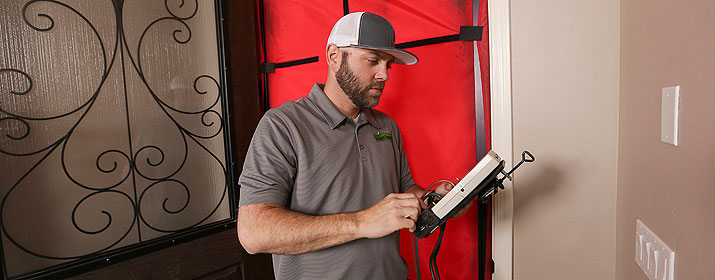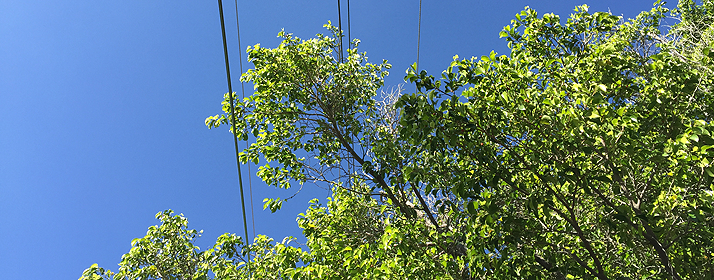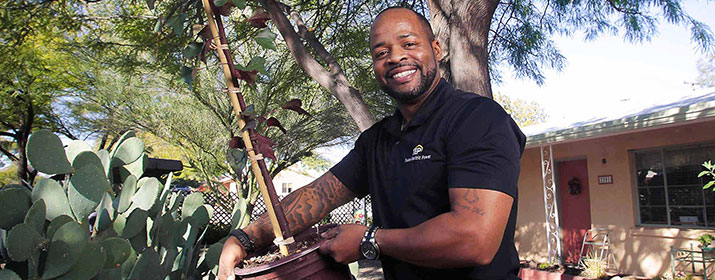
Unwanted air leaks, especially in older homes, account for between 25 and 40 percent of the energy used for home heating and cooling. Leaks lead to higher energy bills and make your home less comfortable by allowing in moisture, dust, noise and drafts.
Reducing the amount of air that leaks in and out of your home is a cost-effective way to reduce your annual energy costs by up to 10 percent as well as reduce cold drafts and improve indoor air quality.
The amount of air leakage in your home depends on the number and size of leaks and the difference between the inside and outdoor air pressure. These factors erode the effectiveness of your home’s “envelope” – the collective barriers that keep conditioned air inside and unconditioned air out.
“Building better homes began in the 1970s with the introduction of ‘building science,’” explained Gabriel Esquibel, TEP Technical Specialist. “This came about during the energy crisis when building codes were improved to create homes with tighter envelopes for greater energy efficiency. Prior to this time, many homes had little to no insulation.”
Pressure differences caused by wind, indoor/outdoor temperature differences, chimney flues and exhaust fans also can affect how much conditioned air escapes your home. Homes with tighter envelopes are more energy efficient, though they also can be vulnerable to mold and poor air quality without proper fresh air ventilation, Esquibel cautioned.
Common places for leaks include electrical outlets, baseboards, attic hatches, window-mounted air conditioners, appliance or exhaust fan vents, and skylights.
“Recessed lighting, which is popular in many homes, also can be a source of leaks,” added Esquibel. “Most of the lighting cans are not sealed, which allows heated air to escape.” He advises replacing uninsulated fixtures with new sealed LED adaptors.
DIY Leak Detection
While hiring a professional to conduct an energy assessment is best, you can complete a simple “do-it-yourself leak detection test yourself using a few different methods. Make a list of the rooms in your home, and then walk room to room, noting the results on your checklist.
- Visual inspection – Check the caulking and weather-stripping around your windows or doors to look for cracks or missing pieces.
- Pressure Test – Turn off all fuel source appliances on a cool, windy day. Shut all windows, exterior doors and fireplace flues. Turn on all the exhaust fans that blow air to the outside of your home, such as bathroom fans and stove vents. Light an incense stick and pass it around the edges of common leak sites. Wavering smoke indicates a draft or leak. You can also feel drafts with a wet or damp hand.
- Flashlight Test – Shine a flashlight in a darkened room over all potential gaps while someone looks outside the home. The light will shine through larger gaps, though this won’t locate the smaller ones.
- Bill test – Close a door or window on a dollar bill or piece of paper. If you can pull the paper out easily without resistance, the opening is large enough to allow leaks. Install weather stripping or sweeps around doors to tighten the seal.
Sealing the Leaks
Simple and inexpensive fixes include installing door sweeps and weather stripping around doors, as well as caulking around windows and areas where plumbing, ducts, cables and wiring enter the home. A foam sealant can be used on larger gaps around baseboards and windows. Adding foam gaskets to electrical sockets and switch plates also is a low-cost fix.
If you have a fireplace, inspect the flue damper to make sure it closes tight and isn’t warped, which can allow cold air to enter your home.
If you can access an insulated attic, check your insulation for thin or dirty spots that might let in air and use a low-expansion spray foam to seal these leaks. “When your house was built, the builder likely installed the amount of insulation recommended at that time,” Esquibel said. “But given today’s building higher standards, the level of insulation is probably inadequate.”
For more information about leaks and solutions, visit the Energy Star website.
Professional Assistance
If you find many leaks, consider having a professional conduct a home energy audit. This will give you a comprehensive assessment of your home’s energy use and efficiency and identify problem areas so that you can prioritize which improvements will give you the greatest return on investment in cost savings.






